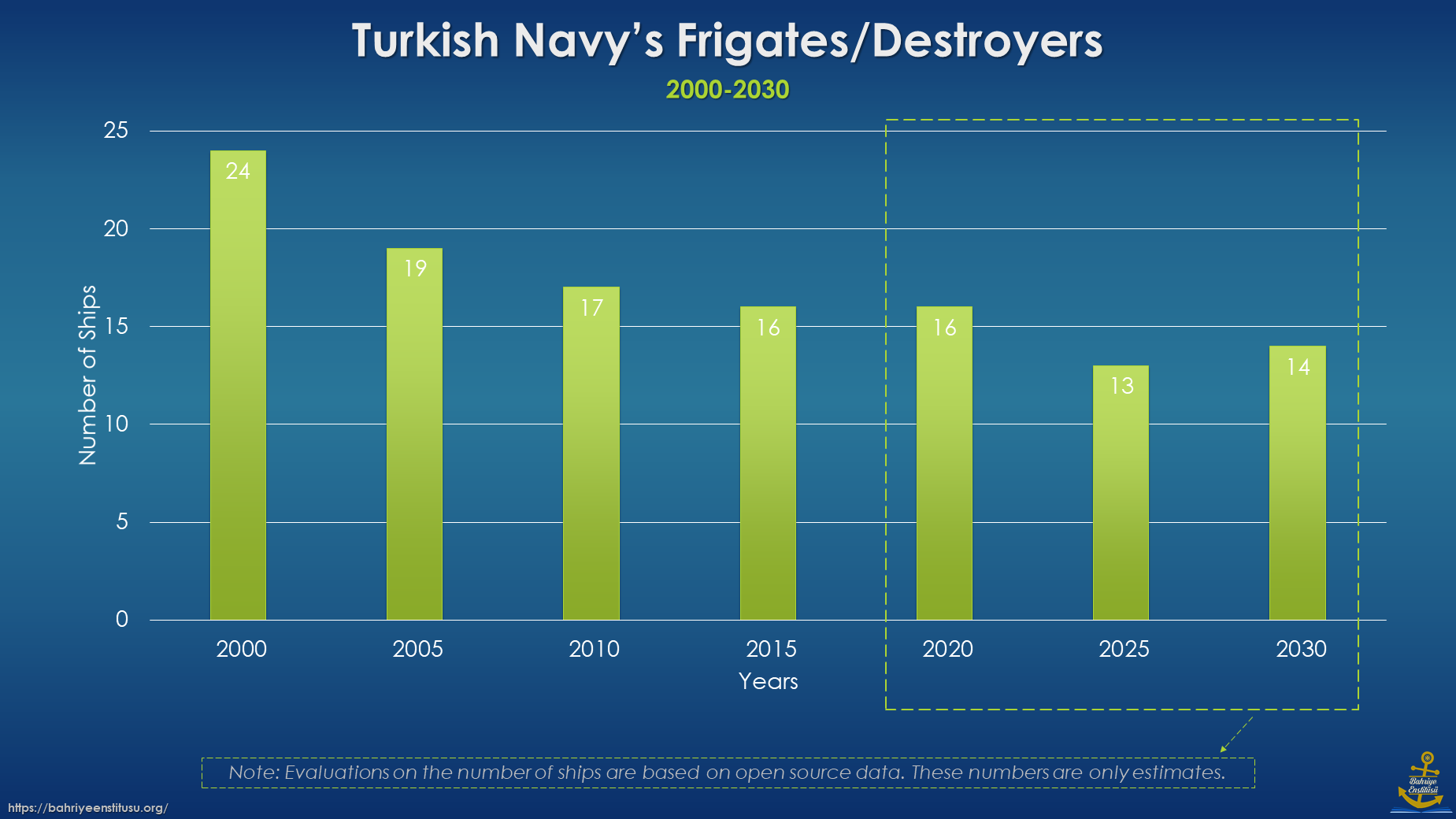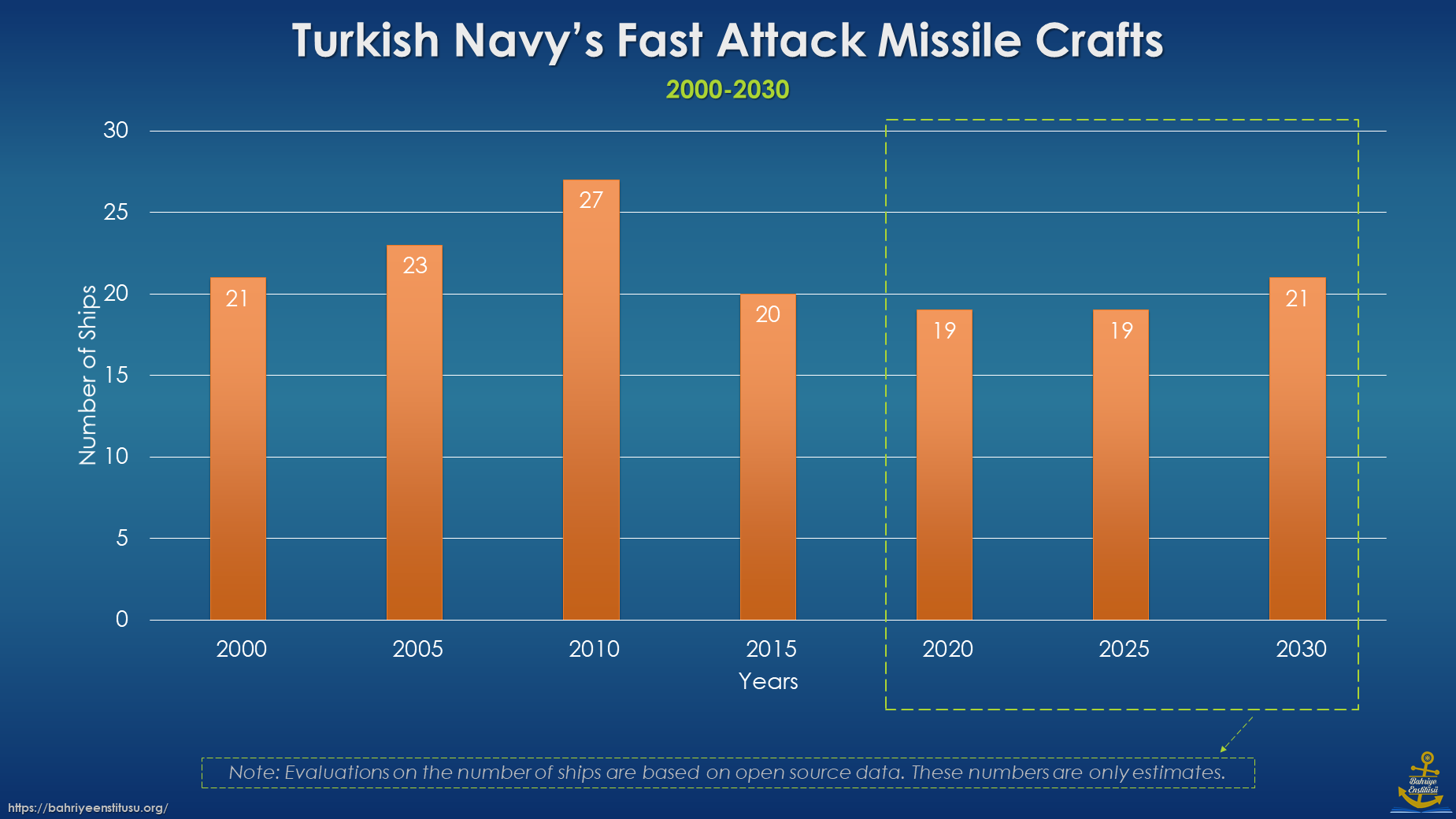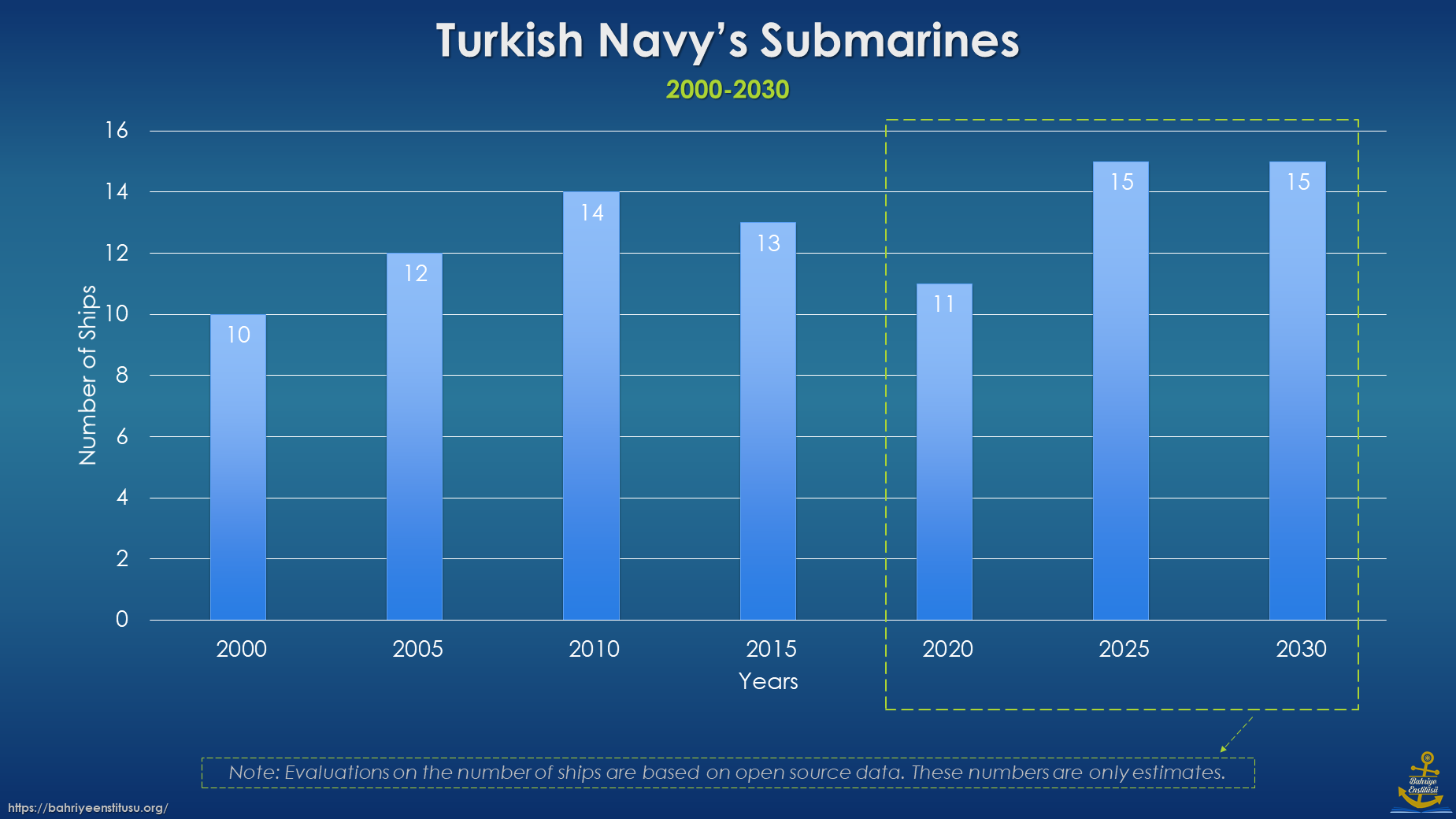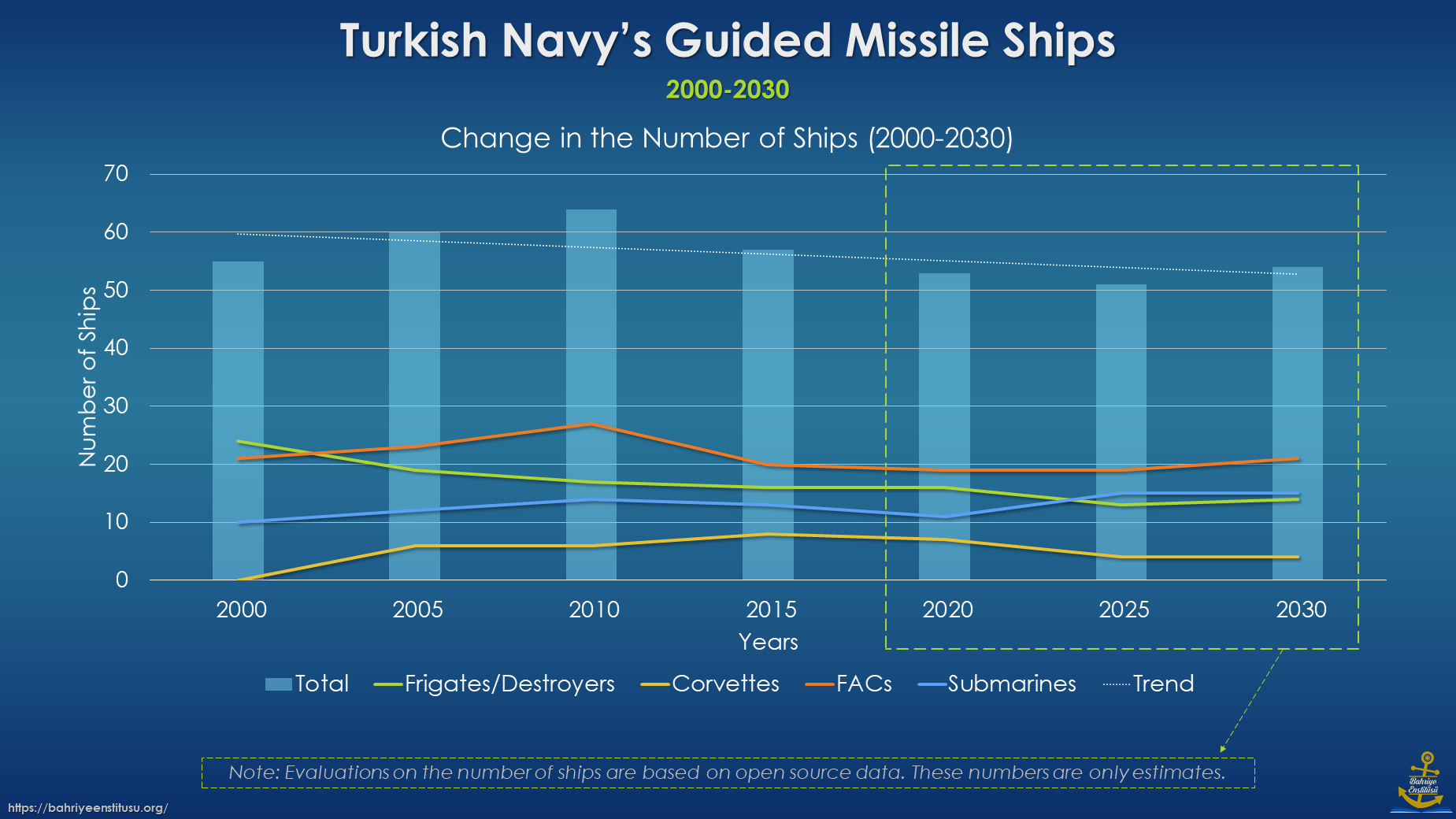Introduction
This study investigates the change in the number of guided-missile ships of the Turkish Navy between the years 2000 and 2030, and touches on the procurement plans. The results suggest that the total number of guided-missile ships (frigates/destroyers, corvettes, fast attack crafts, and submarines) decreases for the time period focused on. Additionally, the fleet is aging and this trend will continue until the 2020s. However, in this period, Turkey has gained a capacity of building its own indigenous guided-missile ships, combat management systems and weapons. [1]
Change in the Number of Guided Missile Ships Between 2000 and 2030
Frigates (and Destroyers)
The frigates served in the Turkish Navy since 2000 are shown below.
| Class | In Service | Commissioned | Average Age of the Ships in Service |
| Yavuz | 4 | 1987 | 30 |
| Barbaros | 4 | 1997 | 20 |
| Gabya | 8 | 1980* | 37 |
| Tepe | (-8) | 1971* | 34 |
| * Commissioning date in the U.S. Navy. | |||
Yavuz Class Frigates are aging, and they will be replaced by the second batch of indigenous “İ” class frigates built under the MILGEM (Milli Gemi – National Ship) program.[2] This class of frigates will possible be decommissioned in the first few years of the 2020s. The claims that Turkey once wanted to sell the Yavuz Class frigates to Egypt supports the assessment that these ships will not remain in the service until the age of 40.[3]
Barbaros Class Frigates, modernized to gain ESSM (Evolved Sea Sparrow) launching capability and 3D Radar System, are reliable vessels.[4] Considering the modernizations and the ages, the ships are expected to leave service in the 2030s or 2040s. Turkish Navy’s plan to further modernize these vessels by switching from TACTICOS to indigenous BARBAROS Combat Management Systems and improving the fire control system supports this assessment.
Gabya (ex- Oliver Hazard Perry, FFG-7) Class Frigates were commissioned in the Turkish Navy after 1998. All 8 ships of the class now have Ship Integrated Combat Management System (GENESIS Combat System). Additionally, 4 ships ((TCG Giresun, TCG Gediz, TCG Gökova, TCG Göksu) gained ESSM capability and 3D Radar Systems.[5] Gabya class ships are the oldest frigates of the Turkish Navy, with the average age of 37. It is expected that the 4 ships that did not receive upgrade will be decommissioned by 2025, while the remaining 4 ships will be decommissioned by 2030.
Tepe (ex-Knox) Class Frigates were taken into service in the Turkish Navy after 1993. All ships of this class had been decommissioned before 2012.
Frigates and/or Destroyers to be commissioned in the next 15 years is shown in the following table.
| Class | Number of Ships (Planned) | To be Commissioned After |
| “İ” | 4 | 2021 |
| TF-2000 | 4 | 2024 |
| TF-100 | 4 | 2029 |
“İ” Class Frigates were designed under the MILGEM (Milli Gemi – National Ship) program. The first ship of the “İ” class, TCG İstanbul, will be the fifth of the MILGEM ships. [6] (The first four ships of MILGEM program are Ada Class Corvettes which will be discussed below.) Four “İ” class frigates will be commissioned between 2021 and 2024,[7] and will replace aging Yavuz Class frigates.[8]
Air Defense Warfare Frigate/Destroyer (TF-2000) Project is the continuation of the MILGEM concept projects. The “İ” class ships will be improved to perform regional air defense and probably be armed with more missiles. It was first announced that TF-2000 ships would be frigates. However, a recent official announcement in the Turkish Navy’s website confirmed that the project includes destroyers. The project is still in the design phase.[9] The first ship is expected to enter service in 2023 or 2024. This class of ships will possibly replace 4 of Gabya class frigates.[10]
TF-100 is another follow-on project of the MILGEM design. It is foreseen that 4 frigates will be built, and the first two will possibly enter service by 2030.[11]
Note: It was first announced that the TF-100 ships will be the third batch of MILGEM design ships. However, the plans have changed as the procurement process proceeded slower than expected. Some other reasons for this change appear to be the procurement of LHD and the urgent need for air defense ships. There is not much information about the TF-100 project, and it is unknown whether it will continue or not. Nevertheless, the number of frigates is already declining, and the Turkish Navy needs new frigates to replace the old ones. Thus, our assessment is that the Turkish Navy will start building new frigates or destroyers right after TF-2000 project. The name of the project may be different than “TF-100” though.
Corvettes
Some information about the Turkish Navy’s corvettes is shown in the following table.
| Class | In Service | Commissioned | Average Age of the Ships in Service |
| Burak | 6 | 1976* | 41 |
| Ada | 2 (+2) | 2011 | 6 |
| *Commissioning date of the ships in the French Navy. | |||
Burak (ex-Type A-69 D’Estienne D’Orves’) Class Corvettes, entered service in the Turkish Navy in the 2000s. [12] The ships are pretty old, with an average age of 41. They will probably be decommissioned in the short term.
Ada Class Corvettes, are the first batch of indigenous MILGEM ships. The first two ships, TCG Heybeliada and TCG Büyükada, entered service in 2011 and 2013, respectively. The third ship, TCG Burgazada will be commissioned in 2018; while the last ship of the class, TCG Kınalıada, is expected to enter service in 2020. [13] It seems that the Turkish Navy will have only 4 corvettes in the long term.
Fast Attack Missile Crafts (FACs)
Turkish Navy’s fast attack crafts (missile) served after 2000 are shown below.
| Class | In Service | Commissioned | Average Age of the Ships |
| Kılıç | 9 | 1998 | 14 |
| Doğan | 4 | 1977 | 39 |
| Rüzgar | 4 | 1986 | 31 |
| Yıldız | 2 | 1997 | 21 |
| Kartal | (-9) | 1966 | 44 |
| Türk | (+10) | 2018* | – |
| * It is now clear that the first ship of the new Türk (Turkish) type fast attack crafts will not be commissioned in 2018. | |||
Kılıç and Yıldız Class FACs are expected to be in service till the 2030s or 2040s.
Turkish Type FACs will be commissioned in the following years. However, it is still unclear that in which shipyard the vessels will be built and that when the shipbuilding procedures will start. The decision on the number of Turkish Type FACs has not yet been given, though it is planned to be between 4 and 10. [14] In the analysis for the FACs, it is assumed that 10 Turkish Type FACs will be commissioned by 2030.
Doğan and Rüzgar Class FACs are aging and they will possibly be decommissioned in the 2020s. A few of them may be decommissioned even earlier.
All Kartal class FACs were decommissioned. [15]
Submarines
Turkish Navy’s submarines that are already in service or expected to be in service in the future is shown below.
| Class | In Service | Commissioned | Average Age of the Ships |
| Ay | 6 (-2) | 1975 | 35 |
| Preveze | 4 | 1994 | 22 |
| Gür | 4 | 2003 | 13 |
| Reis (HBT’li) | (+6) | 2021 | – |
| MİLDEN | – | 2030s | – |
Two of the Ay Class submarines have lately been decommissioned. There are currently four Ay class submarines in service.[16] Two of the remaining, TCG Doğanay and TCG Dolunay, have been modernized. [17] It is assumed that two submarines that did not receive upgrades will be decommissioned in the next five years. For the two modernized submarines, one is expected to leave service at the end of the 2020s and the last one will possibly be decommissioned at the beginning of 2030s.
| Ship | Commissioned | Age |
| Batıray | 1978 | 40 |
| Yıldıray | 1981 | 37 |
| Doğanay | 1984 | 34 |
| Dolunay | 1989 | 29 |
Gür and Preveze Class submarines are expected to be in service until the 2030s or 2040s.
6 Reis Class Submarines will enter service between 2021 and 2026. [18] The first submarine of the class will be launched in 2018. [19]
MILDEN (Milli Denizaltı – National Submarine) Project includes procurement of indegenous submarines in 2030s. [20]
Discussion
Turkish Navy’s official publications “Towards Blue Waters” and “Turkish Naval Forces Strategy,” published in 2000[21] and 2015[22] respectively, clearly suggest an increase in the numbers of the ships. However, the results show that the total number of the guided-missile ships of the Turkish Navy is slightly decreasing. An enlargement in terms of numbers will not be achieved by 2030. The author believes that the decrease is not a result of a changing naval strategy but possibly result of other factors. Moreover, it is unknown whether the current economic situation affects the future procurement plans.
Additionally, the fleet is aging; but with new procurement plans, the average age of the guided-missile ships will decline dramatically after 2020.
Main Assumptions
- It is assumed that the Navy will retire ships within 5 years when a ship reaches 40 years of service.
- If a ship passed a significant modernization phase, we assumed that she will remain in service for 5-10 more years.
This article was first published in Turkish in the following page: http://bahriyeenstitusu.org/2017/09/30/turk-deniz-kuvvetlerinin-gudumlu-fuzeli-gemileri-2030-projeksiyonu/
References & Notes
[1] All the data and information provided in this study are based on open source articles and websites. The results may not fully reflect the procurement plans of the Turkish Navy.
[2] Jane’s Defence Weekly, “Offshore Ambitions: Assessing the Fruits of Turkey’s Maritime Industrial Strategy,” accessed September 19, 2017, http://www.janes360.com/images/assets/297/46297/assessing_the_fruits_of_Turkey_s_maritime_industrial_strategy.pdf; “Naval Analyses: Turkish Navy Modernization and Shipbuilding Plans through 2030,” accessed September 19, 2017, http://navalanalyses.blogspot.com.tr/2017/09/turkish-navy-modernization-and.html.
[3] Arda Mevlütoğlu, “IDEF 2015 İzlenimleri,” Siyah Gri Beyaz, accessed August 30, 2017, http://www.siyahgribeyaz.com/2015/05/idef-2015-izlenimleri.html.
[4] Turkish Naval Forces, “Frigate Projects,” accessed July 20, 2017, https://www.dzkk.tsk.tr/icerik.php?dil=0&icerik_id=76.
[5] Ibid.
[6] AA, “İlk Milli Fırkateynin Yapımına Başlanıyor,” Hürriyet, January 18, 2017, http://www.hurriyet.com.tr/ilk-milli-firkateynin-yapimina-baslaniyor-40339495.
[7] Türk Deniz Kuvvetleri Komutanlığı, “18 Kasım 2014 Tarihli Duyuru,” accessed August 27, 2017, https://www.dzkk.tsk.tr/guncelduyuru.php?id=523&dil=1.
[8] Jane’s Defence Weekly, “Offshore Ambitions: Assessing the Fruits of Turkey’s Maritime Industrial Strategy”; Turan Oğuz, “I Sinifi Firkateyn,” Turk Savunma Sektoru, March 1, 2016, http://turksavunmasektoru.com/i-sinifi-firkateyn/.
[9] Türk Deniz Kuvvetleri Komutanlığı, “Fırkateyn Projeleri.”
[10] Turan Oğuz, “TF-2000 Firkateyni,” Türk Savunma Sektoru, March 9, 2016, http://turksavunmasektoru.com/tf-2000-firkateyni/.
[11] “4.4 SSM 3. ÖDY Konferansı-TERSANELER GM.pdf,” accessed August 30, 2017, http://www.ssm.gov.tr/anasayfa/hizli/duyurular/etkinlikler/konferanslar/Documents/20170605_Sunumlar/4.%20PANEL%20MSB%20Gn.Md.ler/4.4%20SSM%203.%20%C3%96DY%20Konferans%C4%B1-TERSANELER%20GM.pdf.
[12] “Type A-69 D’Estienne D’Orves Frigates,” accessed September 10, 2017, https://www.globalsecurity.org/military/world/europe/d-orves.htm.
[13] “Ada Sınıfı Korvet Projesi,” Türk Deniz Kuvvetleri Komutanlığı, accessed August 15, 2017, https://www.dzkk.tsk.tr/icerik.php?dil=1&icerik_id=72; Türk Deniz Kuvvetleri Komutanlığı, “18 Kasım 2014 Tarihli Duyuru.”
[14] SSM, “Türk Tipi Hücumbot Projesi,” accessed September 21, 2017, http://www.ssm.gov.tr/anasayfa/projeler/Sayfalar/proje.aspx?projeID=239.
[15] https://t.co/8pxeuEDDQ9
[16] Cem Devrim Yaylalı, “AY CLASS (209 Type 1200),” Bosphorus Naval News, January 5, 2013, https://turkishnavy.net/submarines/atilay-class-209-type-1200/.
[17] “Ay Sınıfı Denizaltı Modernizasyonu Projesi,” STM | Projeler, accessed August 30, 2017, https://www.stm.com.tr/tr/faaliyet-alanlari/muhendislik/yetkinlikler/deniz-platformlari/projeler/ay-sinifi-denizalti-modernizasyonu-projesi.
[18] Türk Deniz Kuvvetleri Komutanlığı, “18 Kasım 2014 Tarihli Duyuru.”
[19] “Işık: ‘Reis’ Sınıfı Denizaltı 2018’de Denizle Buluşacak,” MİLLİYET HABER – TÜRKİYE’NİN HABER SİTESİ, accessed August 30, 2017, http://www.milliyet.com.tr/isik-reis-sinifi-denizalti-siyaset-2367260/.
[20] Türk Deniz Kuvvetleri Komutanlığı, “15 Haziran 2017 Tarihli Duyuru,” accessed August 10, 2017, https://www.dzkk.tsk.tr/guncelduyuru.php?id=1143.
[21] Açık Denizlere Doğru: Türk Deniz Kuvvetleri’nin Bir Portresi (Deniz Kuvvetleri Komutanlığı, 2000).
[22] Türk Deniz Kuvvetleri, Türk Deniz Kuvvetleri Stratejisi, 1st ed. (Deniz Basımevi, 2015), https://www.dzkk.tsk.tr/data/icerik/392/DZKK_STRATEJI.pdf.







